
hartleyfamily.uk - The HARTLEY Surname History
Where is 'HARTLEY Country' ?

This view over the Colne Valley overlooks Pendle Hill with the Forest of Trawden behind the viewer [hartleyfamilyorguk]
Many researchers see 'HARTLEY Country' as the area around the Lancashire and Yorkshire borders, especially north and east of Burnley, and up through the Pennines to Cumbria, separated by the Yorkshire Dales. The southern area includes the towns and parishes of Marsden, Colne, Todmorden, Wycoller, Trawden, Bacup and Haworth as well as Burnley itself, and Manchester, Oldham, Nelson and Backburn in Lancashire and Leeds, Halifax, Bradford, Wakefield, Sheffield, and Barnoldswick in Yorkshire. The northern area includes the village of Hartley in Cumbria.
Throughout
the 19thC, Yorkshire and Lancashire were the counties most populated by HARTLEYs.
In 1841 Yorkshire held the No.1 spot 4,502, closely followed by Lancashire
4,075, then Middlesex [London] 290, Cheshire 238 and Cumbria 216. Halifax, Bradford
Wakefield, Sheffield and Barnoldswick were the most populated parishes. In
1851 it was Yorkshire, with Leeds, Bradford, Keighley, Stanley and Bigley
as the top parishes. In 1861, Lancashire took the No.1 position from
Yorkshire though more HARTLEYs were still being born in Yorkshire. Top parishes
were Burnley, Colne, Blackburn, Manchester and *Habergham Eaves. By 1871
Yorkshire had regained the top spot, with Leeds, Bradford, Stanley, Keighley
and Horton as the most populated parishes.
In 1881 all changed again, as most HARTLEYs now lived in Lancashire 7,536 [47%] followed closely by Yorkshire 7,157 [46%], and by London 775 >5%, Durham 364 >2.5% and Cheshire 343 <2%. However births showed a slightly different ratio, Lancashire 7,120 48% and Yorkshire 6,842 45% with Middlesex 567 <3.5%, Cheshire 369 >2.5% and Cumbria 344 >2.5%. The most populated parishes by HARTLEYs were **Marsden, Colne, Burnley, Blackburn and *Habergham Eaves.
By
1891 there were 19 049 HARTLEYs in England and Wales of whom 8034 [42%]
lived in Lancashire and 6994 [37%] lived in Yorkshire, followed by
London 681 3.5%, Cheshire 403 <2% and Durham 373 >2%. However, only 7,192
were actually born in Lancashire so obviously HARTLEYs had moved there to work.
The most populated parishes by HARTLEYs were Colne [up from 2], Burnley [up
from 3], **Marsden [down from 1], *Habergham Eaves [up from 5] and Blackburn
[down from 4].
Most had occupations in Cotton Mills and Coal Mines or were House Keepers, Dress
Makers and Labourers.
By
1901, the numbers had grown to 9,201 [almost 50%] in Lancashire and
7,776 [just over 40%] in Yorkshire [almost doubled since 1841], followed
by London 837 4%, Durham 463 2.5% and Cheshire 371 2%.
The most populated parishes by HARTLEYs in Lancashire were Burnley [up from
2], Colne [down from 1], Nelson [new in], Blackburn up from 5] and Rochdale
[new in]. [gone are **Marsden and *Habergham Eaves].
Throughout the 20thC HARTLEYs moved from Lancashire and Yorkshire to other areas of Britain, and emigrated to many places throughout the world. New industries in the Midlands and South [cars, aircraft etc.] attracted skilled heavy industry workers from the North.
Today, most HARTLEY births occur in [1] Yorkshire 39% and [2] Lancashire 34%, followed by smaller numbers in London 5%, Cheshire 4.5%, Warwickshire <3%, Hampshire >3%, Essex >3%, Surrey >3%, Kent 2.5% and Derbyshire 2.5%.
[NB: HARTLEY villages are also found in the South of England see: HARTLEY Place Names ]
HARTLEY Manor Hall [HARTLEY Castle] near Kirkby Stephen, Cumbria [Cumbria Record Office, Kendal MUSGRAVE family, baronets, of Hartley Castle, Westmoreland: Edenhall estate and manorial records, including papers and rough sketches for rebuilding of Edenhall (including Robert Smirke account), 1796-1830 (WD/ CAT/MUS). ]
There are remains of a Norman Castle named Pendragon Castle just south of Kirkby Stephens dating from 1180, maybe earlier or later, occupied by Sir Andrew de HARCLA. Also a fortified Manor Hall named Hartley Castle [also known as Harcla Castle and Hardcla Castle] at Hartley village, given to Sir Andrew de HARCLA by King Edward 11 in 1315. Sir Andrew also had possession of Hartley Manor, Mallerstang Forest and Smardale.
 PENDRAGON CASTLE. The Norman Castle of Pendragon is reputed to have been
founded by Uther Pendragon, the father of King Arthur. According to legend,
Uther Pendragon and a hundred of his men were killed here when the Saxon invaders
poisoned the well. There are also claims that the Romans built at least a temporary
fort here, along the road between their forts at Brough and Bainbridge. But
apart from legend and supposition there is no real evidence that there was any
building here before the Normans built their castle in the 12th Century, about
the year 1180. The Castle was built next to the River Eden in the Vale of Mallerstang,
probably by Hugh de MORVILLE [Lord of Westmoreland], Hugh de KEVELIOC [Earl
of Chester] or by his son, Ranulph de MESCHINES. However some say it was built
as late as 1314.
PENDRAGON CASTLE. The Norman Castle of Pendragon is reputed to have been
founded by Uther Pendragon, the father of King Arthur. According to legend,
Uther Pendragon and a hundred of his men were killed here when the Saxon invaders
poisoned the well. There are also claims that the Romans built at least a temporary
fort here, along the road between their forts at Brough and Bainbridge. But
apart from legend and supposition there is no real evidence that there was any
building here before the Normans built their castle in the 12th Century, about
the year 1180. The Castle was built next to the River Eden in the Vale of Mallerstang,
probably by Hugh de MORVILLE [Lord of Westmoreland], Hugh de KEVELIOC [Earl
of Chester] or by his son, Ranulph de MESCHINES. However some say it was built
as late as 1314.
The jurors at the Inquisition p. mortem of Robert de CLIFFORD found that there
is a castle of stone in Mallerstang called Pendragon, held by Andrew de HARCLA
by payment of a yearly rent of 6d. Roger, his son, being then 15 years
old, the custody of the Castle was committed by Edward 11 to Guy de BEAUCHAMP,
Earl of Warwick. Roger coming of age, was drawn into that conspiracy which Thomas,
Earl of Lancaster, formed against the King, and, being taken a prisoner was
beheaded at York. The Inquisition post mortem taken at his death in 1327 found
that he died possessed of this Castle of Pendragon, together with the Forest
of Mallerstang, also that the buildings in the Castle could not be extended,
for that the cost of maintaining the same exceeded the profits thereof.
The fortunes of the Castle, however, were resuscitated when the twice widowed
Idonea VIPONT came into residence; the grand daughter of Robert VIPONT and Idonea
BUSLI, Idonea married a de LEYBORNE and her sister, Isabel, married a CLIFFORD.
The Viponts/Vieuxponts/de Veteriponts were a powerful Norman family. William
de VIEUXPONT married Maud de MORVILLE, daughter of Hugh de MORVILLE, Constable
of Scotland. The Lady Anne in her Memoirs of the Clifford family tells us that
"Pendragon Castle was Idonea's chief and beloved habitation." Here, in the year
1333, she entertained Balliol, King of Scots, and here also she died, aged 73.
Notwithstanding Balliol's friendly visit a Scottish raiding party destroyed
the castle by fire in 1341. It was repaired by another Roger de Clifford who
married Maud BEAUCHAMP and who died seised of the Castle in 1390–1, leaving
it to his son Thomas. [thanks to Patricia A. Junkin for additional
info on the Vipont family]
 Then again we
find it laid in ruins in 1541, but whether by the Scots or accident by fire,
we have no means of ascertaining. For 119 years it continued a desolate ruin
until it was re-edified by the Lady Anne in 1660. Her diary tells how she formed
the design of restoring the Castle as early as 1615, for a library for a Mr.
Christopher WOBRIDGE. To give an easier access to the Castle she built the neighbouring
bridge over the Eden and, in 1662, "a wall of lime and stone around the Castle
90 roods in compass, with two gates and within it a stable, coach-house, brew-house,
bake-house, wash-house and a little room over the gate which is arched." In
1685 the castle was demolished by Thomas, Earl of Thanet, and it has ever since
continued to be exposed to the ravages of time and tempest.
Then again we
find it laid in ruins in 1541, but whether by the Scots or accident by fire,
we have no means of ascertaining. For 119 years it continued a desolate ruin
until it was re-edified by the Lady Anne in 1660. Her diary tells how she formed
the design of restoring the Castle as early as 1615, for a library for a Mr.
Christopher WOBRIDGE. To give an easier access to the Castle she built the neighbouring
bridge over the Eden and, in 1662, "a wall of lime and stone around the Castle
90 roods in compass, with two gates and within it a stable, coach-house, brew-house,
bake-house, wash-house and a little room over the gate which is arched." In
1685 the castle was demolished by Thomas, Earl of Thanet, and it has ever since
continued to be exposed to the ravages of time and tempest.
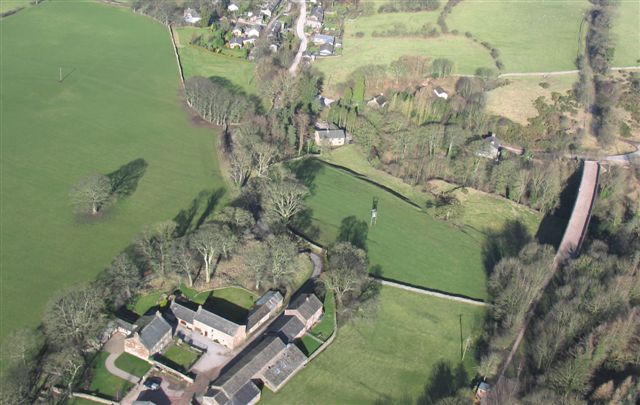 [site of] Hartley Manor Hall [aka Hartley Castle], near Kirkby
Stephen, Cumbria.
[site of] Hartley Manor Hall [aka Hartley Castle], near Kirkby
Stephen, Cumbria.
After the exercution of Roger de CLIFFORD in 1315 for adhering to the faction of the Earl of Lancaster, Hartley Manor Hall [Hartley Castle] was confiscated and granted by Edward 11 to Sir Andrew de HARCLA [anglicized to Andrew de HARCLAY or HARTLEY *see below] and during his ownership was subjected to frequent destruction by the Scots. After the execution of Sir Andrew the Manor Hall and estate passed to Ralph NEVIL, who fortified it in 1323 and subsequently sold them to Sir Thomas de MUSGRAVE. Sir Thomas built his stone tower and received a licence to crenellate it on 4 October, 1353. Sir Richard de MUSGRAVE [died 1615], enlarged it by the addition of Elizabethan wings and transformed the fortress into a mansion. Sir Philip MUSGRAVE repaired and furnished the ancient chapel as also such rooms as had been left unfinished at the time of the Civil War. When about the year 1677 the MUSGRAVE family removed to Eden Hall, Hartley Castle was deserted and allowed to fall into ruin. It was totally demolished between 1704 and 1735 by Sir Christopher MUSGRAVE who died in 1735.
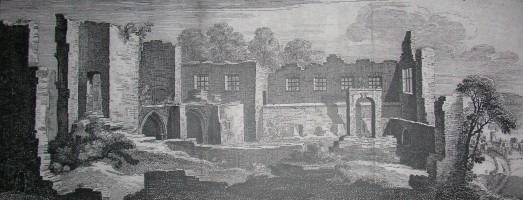 East view showing the ruins of Hartley Manor Hall [aka Hartley
Castle] 1739 [thanks to Tom Hartley for the copy of this Buck engraving]
East view showing the ruins of Hartley Manor Hall [aka Hartley
Castle] 1739 [thanks to Tom Hartley for the copy of this Buck engraving]

Original occupants of Hartley Castle were ...
Husband: Michael de HARCLA Born: between 1235-1260 at: Of Hartley Castle,
Kirkby Stephen, Westmoreland, England, who married between 1255-1285:
Wife: Joan [nee FITZJOHN] Born: between 1240-1265 at: Of, Westmoreland,
England daughter of William FITZJOHN of York.
Children of Michael and Joan were:
*Baron Andrew de HARCLA Born: between 1255-1290 at: Of Hartley Castle,
Kirkby Stephen, Westmoreland, England Died: 1323 at: Carlisle, Cumberland
Isabel de HARCLA Born: between 1255-1290 at: Of Hartley Castle, Kirkby
Stephen, Westmoreland, England. Married Richard le FRANCIS/FRAUNCEYS de VERNON
b: 26 MAY 1263 in Haddon Hall, Derbyshire, England, son of Gilbert le FRANCIS/FRAUNCEYS
of Foremark, Derbyshire, and Hawise de VERNON of Nether Haddon, Derbyshire [formerly
married to Sir Richard de VERNON, whose mother was Margaret VIPONT, descended
from Robert de VIPONT b.abt.1050, a Norman Knight of Normandy.
John de HARCLA Born: between 1255-1290 at: Of Hartley Castle, Kirkby
Stephen, Westmoreland, England Died: 1323 at: Whitehall, Cumberland. He had
a daughter named Isabel, who married Richard de RADCLIFFE c.1344, son of William
RADCLIFFE and Margaret de HINDLEY.
Sarah de HARCLA Born: between 1255-1290 at: Of Hartley Castle, Kirkby
Stephen, Westmoreland, England. Married: ABT 1300 at: Of Great Musgrave, Westmoreland
Died: AFT 1327: Spouses: Thomas de MUSGRAVE Robert de LEYBURN [* de Harcla
also referred to as de Hercle]
* another son not listed is * Henry Harclay [c. 1270 – 1317] Chancellor of the University of Oxford [1313-1316], a former Priest educated at the University of Paris [c.1300] where he was influeneced by Scotus. He was later a Secular Master [c.1310] and Scholastic Philosopher, a radical 'Thinker' who questioned Aristotle regarding Infinity and Eternity. His twenty-nine Quaestiones Ordinariae cover a range of topics in metaphysics, theology, physical science, philosophical anthropology and ethics, which were among the most important of those debated in the early 14thC. The articles provide a window to this era, as Harclay discusses many of the main questions of his day: whether and why we choose what is evil, how God can know the future and we can still be free, what a virtue is, whether the human soul survives death, whether all things are made up of atoms. He was the son of Sir Michael Harclay and Joan Fitzjohn, and the younger brother of Andrew Harclay
*Baron
Andrew de HARCLA was a commander of the English forces at the battle of
Bannockburn in 1314, and he defeated Thomas, Earl of Lancaster at the Battle
of Boroughbridge [Battle of Old Byland] [River Ure, NW of York] in 1322 for
which he was made Lord Harcla, and later Earl of Carlisle. "The 4th Earl
of Hereford led the fight on Boroughbridge, but he and his men were caught in
the arrow fire. Then one of de HARCLAY's pikemen, concealed beneath the bridge,
thrust upwards between the planks and skewered the Earl of Hereford through
the anus, twisting the head of the iron pike into his intestines. His dying
screams turned the advance into a panic."' Sir Andrew used the infantry tactics
which were later to prove so effective against the French at Crécy, and the
rebels were defeated. Andrew de HARCLA was at the height of his fame when he
outmanœuvred and broke the power of the rebel Earl Thomas of Lancaster at Boroughbridge,
and took prisoner Roger de Clifford III. Roger joined the rebels perhaps out
of jealousy of Andrew, or because he was not recognised as Sheriff of Westmorland,
for since his father's death at Bannockburn, deputy sheriffs—Hugh de LOWTHER,
Walter de STRICKLAND, Patric de CURWEN, Henry de THRELKELD, Henry de WARCOP—had
been chosen, or perhaps because castles which were his by inheritance were garrisoned
by others. But on account of CLIFFORD's rebellion the castles of Appleby and
Brougham, as well as Pendragon, were from this time definitely held by Andrew
de HARCLA.
Sadly, it is believed as the result of some political skulduggery, Sir Andrew
was accused of colluding with Robert the Bruce for a truce against the King's
wishes and was hung drawn and quartered at Carlisle Castle, his head ending
up on the Tower of London. His brother John was also executed, leaving his son
John a ward of the king and his sister, Sarah who married Thomas de MUSGRAVE
from nearby Great Musgrave and stayed on at Hartley Manor Hall [Hartley Castle].
[also see Hartley Household below].
Another account states Sir Andrew de Hercla or Harcla was created Earl of Carlisle by King Edward II. in the fifteenth year of his reign. This title he enjoyed but a short time, for in the following year he was arrested in his castle of Carlisle, for treasonable correspondence with the Scots, degraded from his knighthood, by ungirding his sword, and hacking off his spurs, hanged, drawn, and quartered, his head being placed on London-Bridge, and his four quarters thus disposed, one on the keep of Carlisle Castle, one on the keep of the castle at Newcastle, a third on York-Bridge, and the fourth at Shrewsbury.
Bones from the quarter hung at Carlisle Castle were later returned to Andrew's sister, Sarah, in 1328, and buried at Kirkby Stephen's Church in a Musgrave family tomb.At the church is a monumental figure of a man in armour, supposed to have been erected to the memory of Sir Andrew de HARCLA.
It appears Sir Andrew's brother, Michael de HARCLA, was also condemned and had his estate at Harmby confiscated in 1323 and given to Henry le Scrope, later passing to the NEVILL family. Later Roger, his son, being then 15 years old, the custody of Pendragon Castle was committed by Edward 11 to Guy de BEAUCHAMP, Earl of Warwick. Roger coming of age, was drawn into that conspiracy which Thomas, Earl of Lancaster, formed against the King, and, being taken a prisoner was beheaded at York. The Inquisition p. mortem taken at his death in 1327 found that he died possessed of this Castle of Pendragon, together with the Forest of Mallerstang. .
* [see Isabel de HARCLA, above] Richard le FRANCIS/FRAUNCEYS b.26 May 1263 took the surname VERNON and lived at Haddon Hall, Derbyshire. He married Isabel, daughter of Michael de Harcla. They had sons named Richard and William.
* Crosby Ravensworth Hall. The site of Thomas de HASTINGS' house in 1286. "On Whit Sunday of that year Richard le FRANCIS/FRAUNCEYS of Mauld's Meaburn sent William de HARCLA, John le FRANCIS/FRAUNCEYS, Robert de APPLEBY and others to Crosby Ravensworth. There they found Nicholas de HASTINGS, leaning on his bow, outside the gate of his brother's house, and immediately they attacked him. John le FRANCIS/ FRAUNCEYS struck him with a staff and pushed him in the breast and by pressing upon him with his horse thrust him into a ditch. Seeing this William de HARCLA leapt at him with his sword drawn intending to run it into him but the sword fell from his hand and so he failed. Whereupon John le FRANCIS/FRAUNCEYS bade Robert de APPLEBY shoot him with an arrow and Robert did as he was asked and shot him in the breast and Nicholas very quickly died." After which the murderers returned in a body towards the manor house of Mauld's Meaburn. "At once the villagers of Crosby followed them with hue and cry and with intent to arrest and seize the felon, Robert, who shot the arrow. But John le FRANCIS/FRAUNCEYS and William de HARCLA and the others drove them back and by use of weapons rescued Robert de Appleby and took him away into the manor house of Richard le FRANCIS/FRAUNCEYS, who sent them forth, at Mauld's Meaburn, shut the gates after them and allowed no one to go in. Thereon came Alice, wife of Nicholas de HASTINGS, the slain man, she climbed on to a wall and raised hue and cry and sought to obtain entrance for the people with her that they might arrest them, but those inside the manor house prevented anyone from gaining ingress."
* John de Harcla's daughter Isabel married Richard de RADCLIFFE c.1344, son of William RADCLIFFE and Margaret de HINDLEY
"Our particular HARTLEY branch stemmed from the area in Westmoreland, [now Cumbria] England, near to Kirkby Stephen. The village of HARTLEY had a keep or small Castle in the 13th century. Designed to defend the area from the Scottish border raiders, it is now lost within farm buildings on the moor side. The raiders drove the HARTLEYs south, through the "Trough of Bowland" and they then settled in the Pendle area of Lancashire. There are hundreds of HARTLEYs in the area, mainly Johns who begat Johns, making the detailed searching a genealogists nightmare. Links developed between Colne, Trawden, Winewall, and Wycoller in Lancashire and Laneshaw Bridge, Stanbury, Haworth, and Oxenhope in Yorkshire. My own traced ancestors stem from Haworth and Oxenhope, but there are intriguing links to Wycoller". [ thanks to David Hartley E-mail: [David, please submit your new email address]
Adam
de HARTLEY b.c.1188 of Hartley Manor in Dorset was married to Cecilia
de HARTLEY [see **** below] b.c.1192, m.c. 1217 at Great Minterne,
Dorset. They had a third daughter named Claricia b.c.1223.
Their
children were:
[1]
Robert b.c.1218 [see below] d.1244
[2] Isabella b.c.1220 who m. William ST LEODGER
[3] Claricia b.c.1223 who m.c. 1245 Jean de LA LYNDE; d.after 1283
[4] Christiana b.c.1223 who m. William TILLY
[5] Agnes b.c.1227
[6] Isolda b.c.1230
[7]
Johanna b.c.1232
Adam's son, [1] Robert HARTLEY b.c.1218, inherited the Manor in 1244 but died shortly after. Robert's six sisters then inherited, but three sold their shares to Claricia.
[3] Claricia HARTLEY b.c.1223 married Jean de LA LYNDE b.c.1215 Winterborn,
Clenstone, Dorestshire, England; m.c.1245 Winterborn, Clenstone, Dorestshire,
England; later knighted; famous for negotiating the execution of the Treaty
of Paris 1259 between King Richard III of England and King Louis IX of France,
a Treaty that gave former Norseland, Normany, back to the French.
Their children
were:
Sir Walter de la LYNDE b:1248 in Winterborn, Clenstone, Dorsetshire m.Joan [Isabel]
de NEVILL
Geoffrey De La LYNDE b:abt.1250 in Winterborn, Clenstone, Dorsetshire [his son
was named William de HARTLEY, possibly after his mother's surname]
Alexander De La LYNDE b: ABT 1252 in Winterborn, Clenstone, Dorsetshire
Claricia d.after 1283
**** another Cecilia HARTLEY [see above] was born in or around Lancashire b.c.1197. She married Thurston BANASTRE at Walton Le Dale, Makerfield, Lancashire abt 1214 but he died just a few years later. She may have been the same Cecilia HARTLEY in Dorset, ie, she may have gone on to marry Adam HARTLEY in Dorset, they may have been cousins;
Another of the earliest records is that of one Robert de HERTLAY who was living in Yorkshire in 1191 according to Poll Tax returns. He may be related to the HARTLEYs at Hartley Manor Hall [Hartley Castle].
Hartley
Household 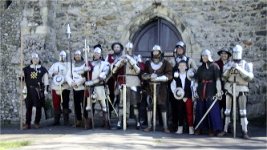 the Household itself has a long history: in 1310, the Earl of Carlisle, Sir
Andreas de HARCLA - a name later anglicized to Andrew of HARTLEY - was made
Commander of Edward II¹s forces against Robert The Bruce and later fought bravely
at the Battle of Bannockburn. http://www.hartleyhousehold.co.uk/main.htm
the Household itself has a long history: in 1310, the Earl of Carlisle, Sir
Andreas de HARCLA - a name later anglicized to Andrew of HARTLEY - was made
Commander of Edward II¹s forces against Robert The Bruce and later fought bravely
at the Battle of Bannockburn. http://www.hartleyhousehold.co.uk/main.htm
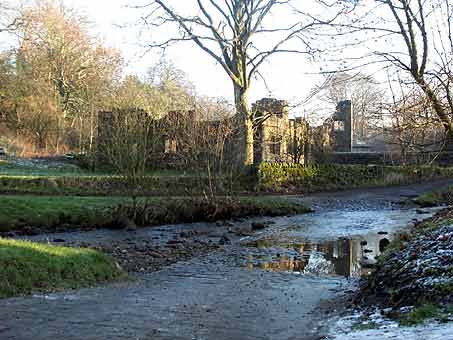 Wycoller Hall, Whalley, Pendle District. Now in ruins, Wycoller Hall
was the ancestral home of the HARTLEYs who were one of the greatest farming
families in this part of Lancashire. Wycoller lies within Trawden township,
together with Winewall and Beardshaw Booth.
Wycoller Hall, Whalley, Pendle District. Now in ruins, Wycoller Hall
was the ancestral home of the HARTLEYs who were one of the greatest farming
families in this part of Lancashire. Wycoller lies within Trawden township,
together with Winewall and Beardshaw Booth.
In 1422 Geoffrey and Robert HARTLEY occupied cow pastures at Over and Nether Wycoller. In 1459 John, James, Henry and William HARTLEY occupied nearby Beardshaw Booth whilst Ellis, Henry and James HARTLEY occupied Over and Nether Wycoller. John HARTLEY occupied nearby Winewall [where Sir William Pickles HARTLEY's ancestors [Hartley's Jam] once lived, see Hall of Fame S-Z
In 1474 Peter HARTLEY occupied Winewall.
In 1507 Geoffrey and John HARTLEY occupied Beardshaw Booth whilst Hugh HARTLEY
occupied Winewall. Wycoller was occupied by Piers HARTLEY the Elder.
In 1527, ten HARTLEYs occupied Beardshaw Booth whilst Roger, Thomas and John
HARTLEY the Elder occupied Winewall. Peter and three other HARTLEYs occupied
Wycoller. In 1528 Nicholas HARTLEY, a Priest, occupied Witley House at Beardshaw
Booth.
The Hall itself is said to have been built by Piers HARTLEY in 1550. It
was passed through the marriage of his daughter Elizabeth in 1611 to Nicholas
Cunliffe in 1646.
The Cunliffe family of Hollins, Accrington was a founding North of England Saxon
family; 12thC Adam de Cunliffe was Baron of Manchester. The Cunliffes kept 'open
house' throughout Christmas, with roast beef and goose, pudding and plenty of
beer, set around a fireplace surrounded by stone benches.
Six generations inhabited Wycoller Hall. John Cunliffe married Grace HARTLEY
in 1628 and lived at Wycoller.The last of the true line was a man called Henry
Owen [who assumed the name Cunliffe]. After his death in 1818 he left substantial
debts so it became the property of the chief mortgager, a Rev. John Oldham who
sold the doors, windows, roofing timbers and stone to support the building of
a cotton mill in Trawden. Wycoller Hall is said to be haunted by a spectre horseman,
and a lady dressed only in black silk.
As well as owning Wycoller, the Cunliffes also took over the Winewall estate
in the 17thC.
In
1589 Roger HARTLEY of Wycoller left four looms in his Will to his sons Christopher
and Thomas HARTLEY.
In 1609, ten HARTLEYs occupied Beardshaw Booth whilst Roger, Thomas and John
HARTLEY the Elder occupied Winewall. Peter HARTLEY occupied Wycoller.
In 1662 Geoffrey, Robert, James, John and Roger HARTLEY occupied land at Trawden.
James HARTLEY occupied Winewall. Other land occupiers were James Hartley of
Lane, James Hartley of Wanless, James Hartley of Alderhurst, James Hartley of
Beyghur, James Hartley of Ludgemoss, John Hartley of Gelford (Gillvert) Clough
and Peter Hartley of Beardshaw Head. In 1662 and 1666 Bernard HARTLEY occupied
Wycoller.
In 1693 Elizabeth HARTLEY died, leaving Blackscarr Croft Mill at Trawden to
her heir, William HARTLEY of Chatburn. Her father was William HARTLEY, her grandfather,
George HARTLEY
 'The Friends of Wycoller' was set up in 1948 with the primary aim to preserve
the Hall. Restoration work on the Hall began in 1950 and the fireplace has been
rebuilt with their help.
'The Friends of Wycoller' was set up in 1948 with the primary aim to preserve
the Hall. Restoration work on the Hall began in 1950 and the fireplace has been
rebuilt with their help.
Now a ruin, Wycoller Hall stands in a picturesque and sheltered situation in
the Wycoller Valley, close to the stream, facing south-west, and is a stone-built
16th-century house of somewhat unusual plan, though the state of dilapidation
it is now in makes an exact understanding of the original disposition of its
parts difficult. It follows, however, to some extent the usual type of a central
hall and end wings, but the kitchen and offices seem to have been on the north-east
side of the hall instead of at the end, and the arrangement of the hall itself
varies in other particulars from the ordinary type. The south-east wing is three
stories in height, but the roof having gone from the whole of the building,
and the walls being broken and imperfect, it is impossible to say whether other
parts have ever been of more than two stories. That there was a room over the
hall is shown by the window remaining in the front elevation and by other evidence
in the hall itself, and the building would probably be of two stories throughout,
with attics in the end wings. The south-east wing, however, seems to have been
almost wholly rebuilt at a much later period, the windows having the appearance
of 18th-century work, and was probably then raised to its present height. Alterations
at the back appear also to have been made at the same time. The north-west wing
has no projection in front of the main wall of the central block, but beyond
it set back 9 in. is a presumably later wing 44 ft. in length and originally
25 ft. wide, but at some still later date an addition 10 ft. wide has been built
in the back. The house, which as it now stands is overgrown with grass and weeds,
was abandoned as a residence after the death of the last of the Cunliffes in
1819, but the later north-west block, the walls of which still stand their full
height of two stories, had its roof intact till about the year 1880. The great
hall and south-east wing are now the property of Mrs. Susannah Benson, and the
rest of the building belongs to the Corporation of Colne. The northeast wing,
which includes the old kitchen, has been repaired and is now used as a cottage.
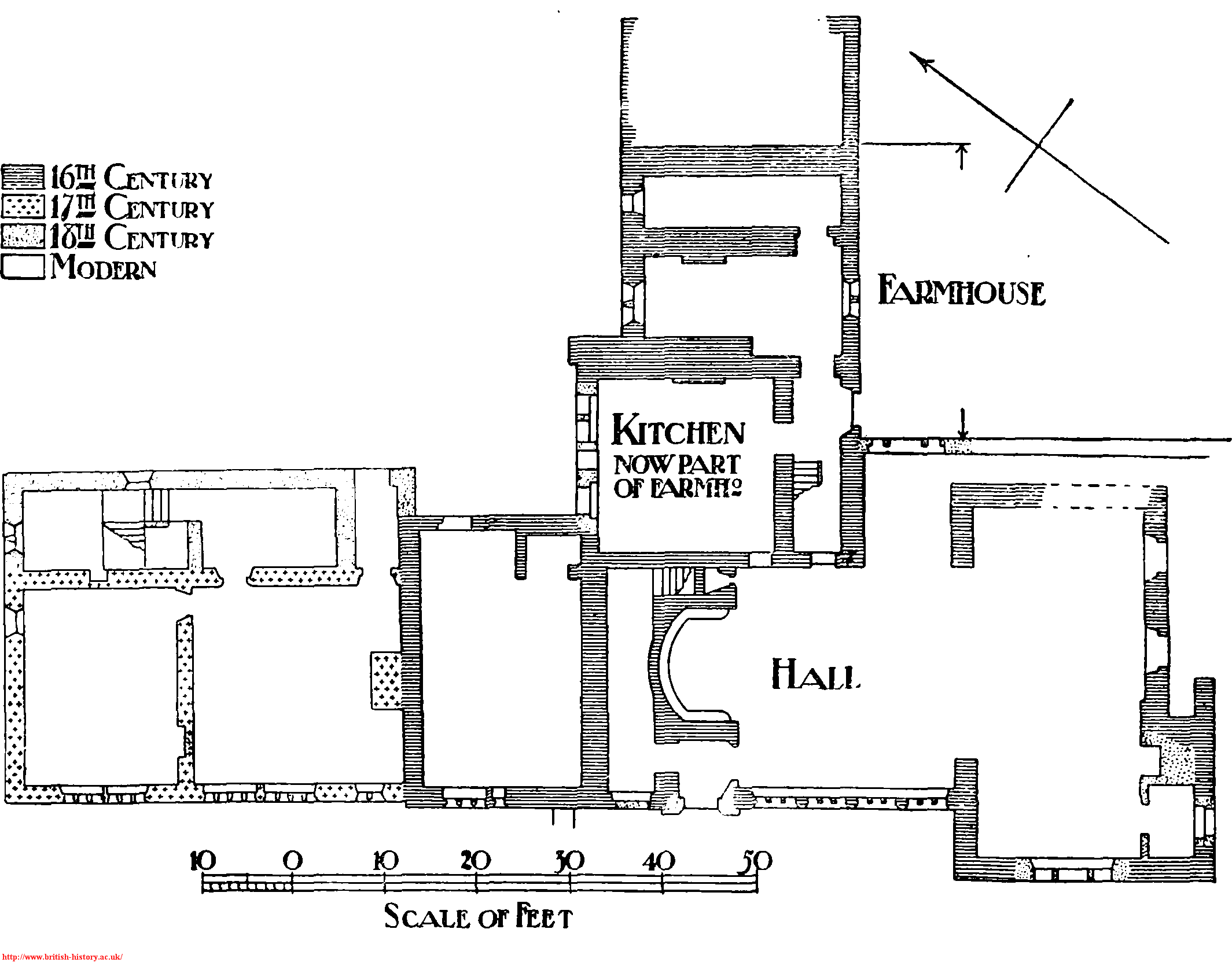 Plan of Wycoller Hall.
Plan of Wycoller Hall.
The great hall is 23 ft. long by 23 ft. 6 in. wide, with a large open fireplace at the north-west end, and a bay in the east corner 9 ft. 6 in. wide and 10 ft. 9 in. deep. The south-east end is now open to the wing, but the wall was apparently formerly carried across, making the hall of the dimensions just stated. The fireplace is 12 ft. 6 in. wide and 7 ft. 6 in. deep, the back curved on plan, with a stone seat carried all round. The stone arch, which has the appearance of having been rebuilt, is struck from three centres, and is 7 ft. 9 in. high to the crown and 5 ft. to the springing under a square hood mould with blank shields in the spandrels. A passage-way 5 ft. wide runs behind the fireplace with a door from the hall at the south end, and a stone staircase at the north leading to the floor above. The outer door at the end of the passage-way is now built up and a later door made in the lobby between it and the hall formed by the deep recess of the fireplace. (fn. 29) The hall is lit by a long low mullioned window of twelve lights on the south-west side and by the bay window opposite, the latter apparently having been rebuilt in the 18th century. On the north-east side between the bay and the fireplace are two four-centred arched doorways, now built up, leading to the kitchen and offices, the spandrels of which are ornamented with shields, blank in one case, but in the other bearing the date 1596, the '96,' however, in the second shield appearing to have been newly cut. On the north-east side of the fireplace, under the stairs, is a small recess in the wall with a curiously shaped opening narrowing at the bottom. Immediately above the windows and fireplace, at the height of 9 ft., a moulded string course runs round the hall, marking presumably the ceiling height, but a large projecting stone corbel at the angle of the bay makes it difficult definitely to reconstitute the hall in its original condition. Of the south-east wing only the walls, or some parts of them, remain, and many alterations seem to have been made. In the south corner is a large fireplace opening 12 ft. wide, partly built up and made into a closet, and there are two outer doors on the southeast wall. The kitchen is 19 ft. square and now forms the living room of a farm-house.
An unusually large number of superstitious and other stories are associated with the house. Wycoller Hall is thought to be “Ferndean Manor” in Charlotte Brontes novel “Jane Eyre”. The Brontes spent much of their life in Haworth, close to Wycoller.

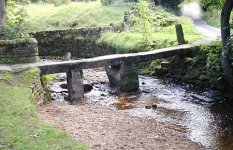
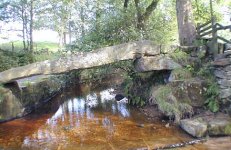 Seven bridges cross Wycoller Beck. Three of the most important are shown above.
Pack-Horse Bridge, a twin arched bridge which may have originated almost 800
years ago, but has been reconstructed over the centuries. Sally Owen, mother
of Wycoller's last squire has led to the bridge's alternative name - Sally's
Bridge. Clapper Bridge is close to the ruins of Wycoller Hall and probably dates
from the late 18th or early 19th century. Grooves in the bridge from the weavers'
clogs were allegedly chiselled flat by a farmer whose daughter was fatally injured
on the bridge. Clam Bridge is possibly more than 1000 years old and is listed
as an Ancient Monument. It is a single slab laid across Wycoller Beck and once
had a handrail. In 1989 and again in 1990 the bridge was swept away and cracked
in two. It was repaired and replaced in 1991.
Seven bridges cross Wycoller Beck. Three of the most important are shown above.
Pack-Horse Bridge, a twin arched bridge which may have originated almost 800
years ago, but has been reconstructed over the centuries. Sally Owen, mother
of Wycoller's last squire has led to the bridge's alternative name - Sally's
Bridge. Clapper Bridge is close to the ruins of Wycoller Hall and probably dates
from the late 18th or early 19th century. Grooves in the bridge from the weavers'
clogs were allegedly chiselled flat by a farmer whose daughter was fatally injured
on the bridge. Clam Bridge is possibly more than 1000 years old and is listed
as an Ancient Monument. It is a single slab laid across Wycoller Beck and once
had a handrail. In 1989 and again in 1990 the bridge was swept away and cracked
in two. It was repaired and replaced in 1991.
The
HARTLEY Family Coat of Arms
A Genealogical and Heraldic Dictionary of the Landed Gentry of Great Britain
... by Bernard Burke
There are several HARTLEY families mentioned in Burke's. They likely have the
same origins, in Lancashire and Cumberland.
1] HARTLEY of Chorlton-cum-Hardy, Manchester, Lancashire
Arms: Ar on a cross gu pierced of the fleld four cinquefoils or in the 2nd and 3rd quarters a martlet s i Crest A martlet sa holding in the beak a cross crosslet fltchee
hartleyfamuilyorguk believe's The HARTLEY Family of Chorlton-cum-Hardy in Manchester derived their name from 'Hearda's Island' at Chorlton, 'HERTHA'S ISLAND', an island where the Earth Goddess Hertha was celebrated and worshipped. [see HARTLEY Family of Chorlton-cum-Hardy Lancashire ]
2] John HARTLEY of Strangeways Hall [1605-1655] was granted in October 1632 the following arms:
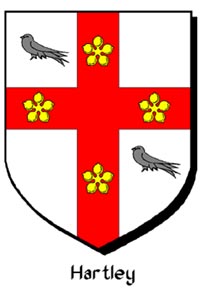 argent, on a cross gules, quarterly pierced of field, four cinquefoils or, in
the first and fourth quarter a martlett sable; and as a crest: a martlett sable,
holding in its beak a cross-crosslet fitchee or” [see the Arms of HARTLEY
Wheaton Aston Hall, Staffordshire]
argent, on a cross gules, quarterly pierced of field, four cinquefoils or, in
the first and fourth quarter a martlett sable; and as a crest: a martlett sable,
holding in its beak a cross-crosslet fitchee or” [see the Arms of HARTLEY
Wheaton Aston Hall, Staffordshire]
Strangeways
Hall was located in Lancashire within two miles of Manchester and was bought
by John HARTLEY in 1624.
The HARTLEY family were Woollen Merchants and Drapers. Nicholas HARTLEY b.c.1560
Manchester>John HARTLEY b.c.1605>Ellen HARTLEY b.c.1629 m.John HARTLEY>Ralph
HARTLEY d.1710 [the Hall then passed out of HARTLEY Family possession]
3] HARTLEY of Bucklebury House, Berkshire and Little Sodbury, Gloucestershire. See: Doctor David HARTLEY in The Hartley Hall of Fame A-F, click on Winchcombe Henry HARTLEY [see HARTLEY Family of Chorlton-cum-Hardy Lancashire ]
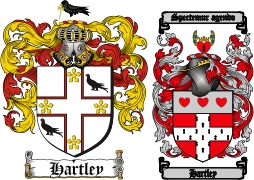 Arms:
"ARG. [Silver] on a cross gu.[Red Cross], pierced of the field four cinquefoils
[four gold five-leafed flowers] or, in the second and third quarters a Marlet
[Blackbird] sa."
Arms:
"ARG. [Silver] on a cross gu.[Red Cross], pierced of the field four cinquefoils
[four gold five-leafed flowers] or, in the second and third quarters a Marlet
[Blackbird] sa."
Crest: "a Martlet [Blackbird] sable, holding in the beak a cross-crosslet,
fitchee, or [a Gold Cross] "
Motto: Vive ut Vivas "Live [life] to the fullest"
4] HARTLEY of Gillfoot, Whitehaven, Cumberland. John HARTLEY b.c.1740 m.29 Aug 1762 Elizabeth MILHAM. >their son Thomas HARTLEY b.c.1770 m.13 Aug 1796 Anne HARTLEY d.16 Jan 1831>their son Thomas HARTLEY b.29 Sep 1802, m.10 Apr 1839 Georgianna-Elizabeth RIMINGTON d.1855>their son Thomas HARTLEY b.21 Mar 1847
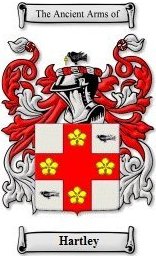 Arms: "ARG. [Silver] on a cross gu.[Red Cross],
pierced of the field four cinquefoils [four gold five-leafed flowers] or, in
the second and third quarters a Marlet [Blackbird] sa."
Arms: "ARG. [Silver] on a cross gu.[Red Cross],
pierced of the field four cinquefoils [four gold five-leafed flowers] or, in
the second and third quarters a Marlet [Blackbird] sa."
Crest: "a Martlet [Blackbird] sable, holding in the beak a cross-crosslet,
fitchee, or [a Gold Cross] "
Motto: Spectemur agendo "Let us be judged by our actions"
[see HARTLEY Family of Chorlton-cum-Hardy, Lancashire ]
5] Same Arms c HARTLEY Wheaton Aston Hall, Staffordshire.
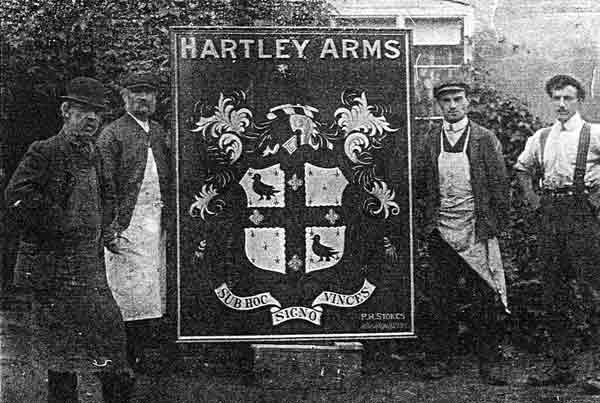 Arms: Erm on a cross engr gu four quatrefoils or in the 1st and 4th quarters
a martlet sa Crest Upon a mount vert a martlet sa in the beak a cross pattte
fltchee or Motto: Sub hoc signo vinces, translated reads "Under this sign you
shall conquer" [see the Arms of John HARTLEY of Strangeways Hall]
Arms: Erm on a cross engr gu four quatrefoils or in the 1st and 4th quarters
a martlet sa Crest Upon a mount vert a martlet sa in the beak a cross pattte
fltchee or Motto: Sub hoc signo vinces, translated reads "Under this sign you
shall conquer" [see the Arms of John HARTLEY of Strangeways Hall]
Hartley's Glassworks and Wearglass Works in Sunderland [1836] and Dumbarton Glass.
ongoing research by hartleyfamilyorguk into a link between the "Hartley Glass" family and Vivien LEIGH, the actress ...
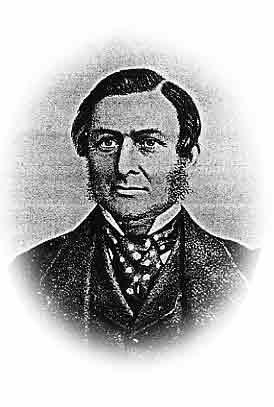 John HARTLEY [1813], along with
his brother James N. HARTLEY [1811], established Hartley's Glassworks
and Wearglass Works in Sunderland in 1836/7; Chance and Sons Glassworks, Smethwick;
partner with his brother-in-law Major Thorneycroft, J. P. in Messrs J. B. Thorneycroft
& Co.'s large Ironworks and Collieries; Director of the L. & N.W. Railway; Deputy
Lieutenant for Staffordshire. Elected Mayor of Wolverhampton 1858. Burial:1884,
St Bartholemew Church, Tong, Shropshire.
John HARTLEY [1813], along with
his brother James N. HARTLEY [1811], established Hartley's Glassworks
and Wearglass Works in Sunderland in 1836/7; Chance and Sons Glassworks, Smethwick;
partner with his brother-in-law Major Thorneycroft, J. P. in Messrs J. B. Thorneycroft
& Co.'s large Ironworks and Collieries; Director of the L. & N.W. Railway; Deputy
Lieutenant for Staffordshire. Elected Mayor of Wolverhampton 1858. Burial:1884,
St Bartholemew Church, Tong, Shropshire.
James
N.HARTLEY [1811] was born 13th Mar 1811, baptized 29th Mar 1811 at Dumbarton,
Scotland. He was sent to Paris for glass work in 1872. He died on 24 May 1886.
James built Ashbrook Hall at Bishopwearmouth [architect Thomas Moore] in 1864.
James
HARTLEY [1704] at Bramley, Yorkshire. He was likely a Glassmaker; m.Sarah
EDDISON 9th Nov 1729 in Leeds Yorkshire. Children: Margaret HARTLEY [1730] at
Bramley; Sarah HARTLEY; Sarah HARTLEY; Mary HARTLEY; Joseph HARTLEY [1735]
at Hunslet, Yorkshire; Margaret HARTLEY; Eleanor HARTLEY; Ruth HARTLEY;
Elizabeth HARTLEY; James HARTLEY; Elizabeth HARTLEY; William HARTLEY [1744]
at Allerton; Benjamin HARTLEY [1745] at Allerton.
Joseph HARTLEY [1735] baptized 27th Feb 1735 at Hunslet Yorkshire. He
died 13th Sep 1794 at Dumbarton, Scotland. Joseph m. Elizabeth SKINNER. Children:
Joseph HARTLEY [1771] at Hunslet, Yorkshire; Abraham HARTLEY [1773] at
Hunslet; John HARTLEY [1775] at Hunslet; Benjamin HARTLEY [1784] at Dumbarton.
Joseph HARTLEY [1771] baptized 19th May 1771 at Hunslet, Yorkshire. m.Martha
SIMPSON 21st Apr 1815 at Dumbarton, Scotland. [[The family of Hartleys as a
whole seemed to travel between Sunderland and Dumbarton in Scotland, both areas
highly active in the Glassmaking industry]]. Children: Ann HARTLEY; Mary HARTLEY;
Margaretta Simpson HARTLEY; Abraham HARTLEY [1821] at Melbury, Somerset; Joseph
HARTLEY [1823] Nailsea, Somerset. They lived at Nailsea Somerset in 1821, Birmingham
in 1830, St Helens, Lancashire in 1834. In 1851 Joseph was a Crown Glass Maker
in Sunderland, Durham [where they lived 1851]. Hartleys Glass Works was established
in Sunderland in 1836/7 and James N. Hartley [1811][Josephs nephew] was
granted a patent for a new process of casting rolled glass which was used and
shipped worldwide. [[tableware from Wearglass Works is highly collectable. Though
the Glassworks closed in 1894, the tradition of glassmaking in Sunderland continued
with a new partnership of James Hartley [grandson of James N. Hartley] and Alfred
Wood from Birmingham teaming up to form Portobello Lane Works]].
John HARTLEY [1775] m.Margaret Laing STEPHENSON [nee KAYLL] 21st Apr
1802 at St Peter Church, Monkwearmouth, Durham. Children: Martha HARTLEY; Jane
Langridge HARTLEY; Maria Booth HARTLEY; Mary Ann HARTLEY; James HARTLEY; John
HARTLEY [1813][see below]; Louisa HARTLEY. He died on 5 Aug 1833
in Birmingham. He was a Glassmaker probably for Dixon's in Dumbarton, Yorkshire,
Nailsea, Somerset & Birmingham. He was one of the country's foremost authorities
in the production of Crown Glass .
George
B THORNEYCROFT b.1821. He lived in Hadley Park, Shropshire and owned theShrubbery
Ironworks, Horsely Fields, Wolverhampton; d.1851. Children: Emma THORNEYCROFT
Emma THORNEYCROFT b.1821 at Hadley Park, Shropshire, d.1909 at Tong, Shropshire.
She married John HARTLEY [1813] 20th Aug 1859. Children: Rosa Mary HARTLEY;
Eleanor Jane HARTLEY; George THOMPSON HARTLEY [1844] [see below]; Alice HARTLEY
[1848];
Rev Canon John Thorneycroft HARTLEY [1849] [see:John Thorneycroft HARTLEY [1849-1935]
English Wimbledon Tennis Champion under Hartley Hall of Fame: Sports]; Charles
Albert HARTLEY [1851]; Constance HARTLEY.
John
HARTLEY [1813] b.Dumbarton Scotland who lived [and died 1884] at Tong Castle,
Shropshire. Along
with one of his brothers James N. Hartley, established Hartley's Glassworks
and Wearglass Works in Sunderland in 1836/7, the first making glass windows
and Wearglass Works making table ware. At the time Hartleys Glass Works was
the more successful of the two business's and James N. Hartley was granted a
patent for a new process of casting rolled glass which was used and shipped
worldwide.
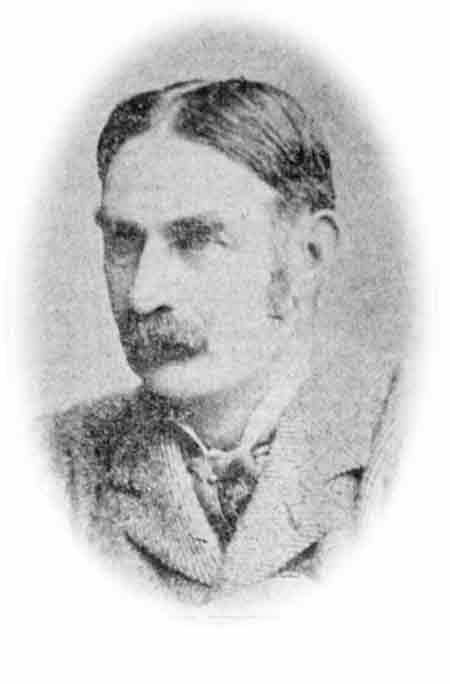 George Thompson HARTLEY was born 1844, lived at Kilsll Hall then lived
[and died July 20, 1917] in Wheaton Aston Hall, Staffordshire. He married Louisa
STONE 1871, daughter of John SPENCER STONE. She died 1892 in Wheaton Aston,
Staffordshire. George opened the "Hartley Arms" at Wheaton
Aston. Burial: 1917, Lapley, Staffs. Children: Ernald George Justinian HARTLEY
was born Abt. 1873. He married Mary Frances WEDGWOOD. Last known address Frilford
House, Abingdon, Berkshire. Children: Geoffrey Ernald Wedgwood HARTLEY;
Mable HARTLEY. Miss H. HARTLEY, m. Gordon-WATSON.
George Thompson HARTLEY was born 1844, lived at Kilsll Hall then lived
[and died July 20, 1917] in Wheaton Aston Hall, Staffordshire. He married Louisa
STONE 1871, daughter of John SPENCER STONE. She died 1892 in Wheaton Aston,
Staffordshire. George opened the "Hartley Arms" at Wheaton
Aston. Burial: 1917, Lapley, Staffs. Children: Ernald George Justinian HARTLEY
was born Abt. 1873. He married Mary Frances WEDGWOOD. Last known address Frilford
House, Abingdon, Berkshire. Children: Geoffrey Ernald Wedgwood HARTLEY;
Mable HARTLEY. Miss H. HARTLEY, m. Gordon-WATSON.
6]
HARTLEY: granted to John HARTLEY Esq of Catterall Hall, Giggleswick Yorkshire.
John and William HARTLEY were solicitors at Giggleswick, Yorkshire.
1881 Census: Dwelling: Catterall Hall, Giggleswick, Yorkshire
William HARTLEY Head M Male [54] Sawley, York Solicitor [William d.1901 aged
76]
Emily HARTLEY Wife M Female [48] Skipton, York Solicitor Wife
John HARTLEY Son U Male [20] Giggleswick, York Solicitor Articled Clerk
William HARTLEY Son U Male [16] Giggleswick, York Solicitor Son
George M. HARTLEY Son U Male [14] Giggleswick, York Scholar
Robert HARTLEY Son U Male [12] Giggleswick, York Scholar
Emily M. HARTLEY Daur U Female [10] Giggleswick, York Scholar
Mary A. HARTLEY Daur U Female [8] Giggleswick, York Scholar
Helena I. HARTLEY Daur U Female [5] Giggleswick, York Scholar
Esther A. HARTLEY Daur U Female [3] Giggleswick, York
Marian BENTHAM Sister In Law U Female [64] Broughton In Furness, Lancashire
Mary E. VANT Visitor U Female [28] Ripon, York, Visitor
Eliza SMALLWOOD Serv U Female [22] Darlaston, Stafford Cook Domestic Servant
Harriet DUCKENFIELD Serv U Female [25] Bristol, Gloucester Housemaid Domestic
Servant
Eliza DUCKENFIELD Serv U Female [23] Bristol, Gloucester Nurse Domestic Servant
John Ledford ROBINSON Serv U Male [16] Settle, York Page Domestic Servant
Arms:
Gu a cross erm on a chief ar three hearts of the field Crest A heart as in the
arms enslgned with a crown vallery or betw two wings barry of six az
7]
HARTLEY of Settle, Giggleswick, Yorkshire.
Same Arms: a canton erm for diff Oral A heart as in the arms ensigned with a
crown vallery or betw two wings barry of six az and or the heart charged with
an erm spot gold for diff
8] HARTLEY of Middleton Lodge near Richmond, Yorkshire. Middleton Tyas, Kneeton and Moulton belonged to ULF before the Conquest in 1066. They then passed to Count ALAN of Richmond in 1086, with Middleton and Kneeton jointly owned by UGHTRED. Down the ages, ownership passed from the SHUTTLEWORTH family to the HARTLEY family; Marmaduke HARTLEY; Leonard William HARTLEY; George HARTLEY [1780-1841]; Leonard HARTLEY; Leonard Lawley HARTLEY in 1857; then to Leonard Laurie HARTLEY in 1879, who died at Hastings St. Leonards-on-Sea, SusDecember 27th, 1883, aged 67. The manor then passed to Colin Douglas EYRE, who was succeeded by his brother Ralph EYRE.
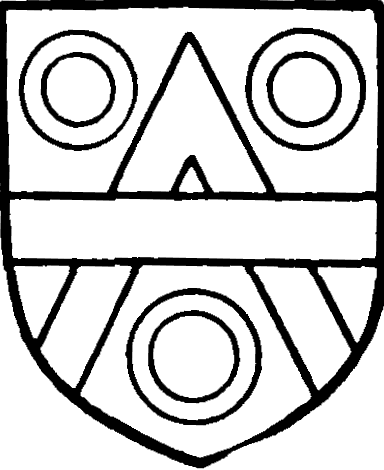 Arms: Or a cheveron between three annulets [rings] gules over all a fesse arure
Crest: A stag couchant reguard ar
Arms: Or a cheveron between three annulets [rings] gules over all a fesse arure
Crest: A stag couchant reguard ar
9]
HARTLEY
of Beech Park, Clonsilla, Co.Dublin, Ireland. [HARTLEY family originally
from Lancashire]. Samuel HARTLEY. His son Rev.William HARTLEY b.1679 of Ballylaghan
Co.Carlow, Ireland. His son Rev.Humphry HARTLEY b.1711 m.Honor. Their son Bartholomew
b.20 Dec 1758 m.10 Dec 1785 Ann AGAR. Their son Bartholomew b.13 Dec 1780 m.2
Jun 1823 Eliza WILSON. Their son Richard Wilson HARTLEY b.24 Mar 1824 m.Hester
HEPENSTALL.
 Arms: "ARG. [Silver] on a cross gulen [Red Cross], pierced of the field four
cinquefoils [four gold five-leafed flowers] or, in the first and fourth quarters
a Marlet [Blackbird] sable. in the second quarter a Rose, [a Red Rose [of Lancashire]
barbed and seeded, proper"
Arms: "ARG. [Silver] on a cross gulen [Red Cross], pierced of the field four
cinquefoils [four gold five-leafed flowers] or, in the first and fourth quarters
a Marlet [Blackbird] sable. in the second quarter a Rose, [a Red Rose [of Lancashire]
barbed and seeded, proper"
Crest: "Out of a Mural Crown, or a Stags Head, proper, holding in the mouth,
a Rose, gules, [a Red Rose [of Lancashire] barbed and seeded, proper"
Motto: Spectemur agendo "Let us be judged by our actions"
[see
HARTLEY Family of Chorlton in Lancashire ]
also, there are the following contributions:
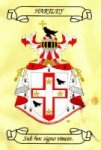 [above the
shield and helmet is the crest which is described as: " A black martlet holding
in the beak a gold cross." - thanks to John L. Dodd]
[above the
shield and helmet is the crest which is described as: " A black martlet holding
in the beak a gold cross." - thanks to John L. Dodd]
Alternative descriptions can be found as follows:
the motto reads "Sub hoc signo vinces", translated reads "Under this sign you
shall conquer" [thanks to Stephen Hartley E-mail: sbhartley@ozemail.com.au ]
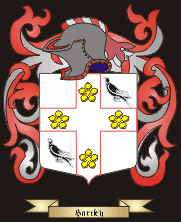
Blazon
of Arms Gules, a canton ermine on a chief argent; three hearts of the field.
Crest A heart as in the arms ensigned, with a crown vallery or; between two
wings barry of six azure and or; the heart charged with an ermine spot or.
[I have in my possession a hand painted representation of The HARTLEY Coat which
belonged to my father. It has been in the family's possession for at least fifty-five
years to which I can personally attest. It closely approximates the home page's
illustration." [thanks to Benjamin W. Hartley E-mail: bhartley@top.monad.net ]
Picture
Gallery of 1800's Victorian England
typical 19thC dress of HARTLEY Family members from Yorkshire and Lancashire
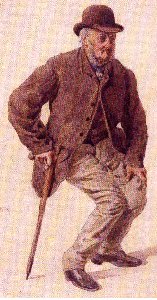
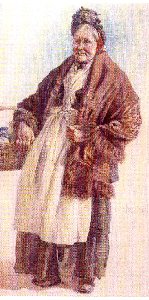
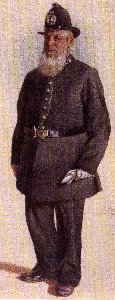
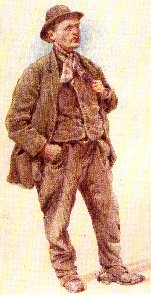
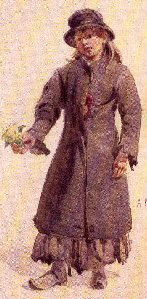
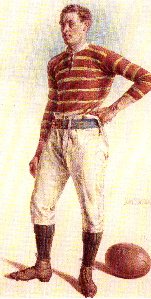
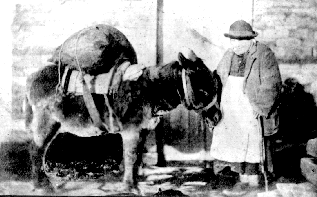 Ailse O'Fussers [
Mary Alice Hartley ]
Ailse O'Fussers [
Mary Alice Hartley ]
The last of the lime gal drivers that plied her calling in the Rochdale district
was a strange character named Mary Alice Hartley, who was more familiarly known
as "Ailse O'Fussers". She kept a small farm, Holough, on the edge of the moorland
above Shawforth. In her palmy days she had as many as twenty gals, and they
carried bags of coal from Land coalpit, near Shawforth, and sometimes lime from
Clitheroe or Burnley. They travelled the packhorse roads from Clitheroe to Bacup
on the moors skirting Shawforth and Whitworth, along the foot of Brown Wardle,
down Cronkeyshaw to Rochdale.
Her appearance was most grotesque and arrested the attention of every person
whom she and her gals passed on their journey. In build she was short and stout,
and she wore over her petticoats a male topcoat. A "Jim Crow" hat was fastened
and secured on her head with a handkerchief over the top of her hat, and tied
under her chin. She carried a long stick in the style of a shepherd, and presented
more the appearance of a man than a woman. Yet she had a lover, named Thomas
Walton, a young farmer who resided with his parents at Hursted Nook Farm near
Pottery. They were indiscreet and when their offspring died she insisted on
carrying the coffin herself to the graveside in Whitworth churchyard. In her
declining days Ailse lived at Potovens, a cottage on the edge of the moor above
Shawforth and carried coal on a donkey's back for her customers. It was a great
favourite of hers, was named "Jerry", shared her dwelling and was fastened to
her bedpost at nights.
Ailse died about 1879 and was buried in Whitworth Churchyard. The ladies of
the village decorated her coffin with a wreath of flowers, and in this ground
on the side of the hill, a short distance from the packhorse road she traversed,
she lies in uncomplaining sleep.
[ from Robertson's "Rochdale and the Vale of Whitworth,1897 image © Rochdale
Local Studies Library ]
HARTLEY
Mine Disaster 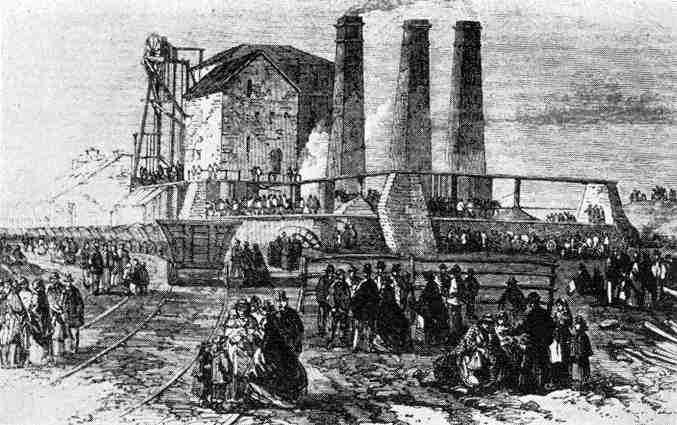 at Hester Pit, Northumberland.
January 1862
at Hester Pit, Northumberland.
January 1862
"Oh, my men, my canny men, they would have done ought for me and there they
are all lying dead and cold" New Hartley is near Blyth 9 miles NNE of Newcastle
in the south-east of Northumberland.
Consisting of Mill Pit, Nightingale Pit, Whin Pit, opened:1754 Owners:1850's
- Carr & Co. May 1929 - Hartley Main Collieries Ltd. 1947 - National Coal Board
[N.C.B.]
Located half-a-mile from the Village Hall, and close to the railway station
of New Hartley, is the old shaft of the Hartley New Pit, made memorable by the
terrible catastrophe which occurred there on Thursday, January 16th, 1862.
At the pit-head was the engine-house, containing the engine for pumping the
water out of the pit supported on a massive beam over the mouth of the pit shaft.
Suddenly, and without a moment’s warning, this ponderous mass of iron snapped
in half thundered down the shaft, crushing the strong wooden wall which divided
the pit into two shafts and filling the shaft with debri as far down as the
yard seam. A cage containing eight men was ascending the shaft at the time the
beam broke. It was at once smashed, and torn as it had been manufactured of
the weakest tin instead of the strongest wrought iron.
Six of the occupants were instantly killed, and two miraculously escaped. This
shaft was the only entry to the mine and being blocked by the mass of iron and
woodwork, the supply of fresh air was cut off from the men imprisoned in the
workings, without a hope of escape. By the Friday afternoon it is probable that
all of the entombed miners had succumbed to the deadly effects of the noxious
gases. In the meantime efforts were made by devoted friends and relatives to
force a passage into the workings.
Day after day, and night after night, they toiled heroically, frequently overcome
by the deadly gases. The whole country was roused by the terrible tidings, and
manifested the utmost interest in the fate of the imprisoned men. On the Sunday
after the accident an immense crowd gathered on the scene, and by the afternoon
a huge crowd was milling round the pit head arriving by trap, railroad, and
on foot. Steadily Mr. Coulson and his brave assistants and volunteers proceeded
with the clearing of the shaft, and on Wednesday morning three of the sinkers,
headed by Emerson, Mr. Coulson’s chief assistant, were able to advance into
the furnace drift, but were unable to proceed far on account of the gas.
In the afternoon one of the shift-men, William Adams, managed to penetrate into
the yard seam through the furnace drift. He was fearfully excited when he came
back to the surface and tore his hair like a maniac while relating his dreadful
news in spasmodic jerks. The bodies of the men and boys were found lying in
rows, all quiet and placid, as if sleeping off a heavy day’s work. Boys were
lying with their hands on the shoulders of their fathers, and one poor fellow
had his arms clasped round the neck of his brother. The sleep like approach
to their death has been pathetically described by Mr. Joseph Skipsey the poet
of the Coal-fields, in his ballad on "The Hartley Calamity" [see below]
On the body of Armour, the back-over man, was found a small memorandum book,
containing the brief but significant last entry: "Friday afternoon, at half-past
two, Edward Armstrong, Thomas Gledstone, John Hardy, Thomas Bell, and others
took extremely ill. We had a prayer meeting at a quarter to two, when Tibbs,
Henry Sharp, J. Campbell, Henry Gibson, and William Paltrier. Tibbs exhorted
us again, and Sharp also." On a shot-box belonging to a hewer named James Bewick
the following pathetic words were scratched, evidently with the point of a nail:
" Friday afternoon. My dear Sarah,—I leave you " No doubt the writer died immediately
afterwards.
The bodies were interned in Earsdon churchyard on Sunday, the 26th January,
in ground set apart for the purpose, in the presence of a vast concourse of
spectators. The sad procession was necessarily a long one, and many of the bodies
were in the ground before the last had left the desolated village, which was
four miles away. The terrible calamity called on the sympathy of all classes
of society for the widows and children of the Hartley men, and a noble fund
for their relief was speedily subscribed.
On that day, 204 men and boys were lost when the giant beam of the pumping engine
snapped and twenty tons of cast iron hurtled down the only shaft, blocking all
attempts at rescue for several vital days. Nearly all the fatalities were caused
by gas which quickly built up in the workings, and the entire community of New
Hartley was overwhelmed by the tragedy. Almost every home in the village lost
a breadwinner, and in some the coffins were said to have been stacked from floor
to ceiling. The funeral that followed on January 26th was remembered for generations
- for despite the fact that a few bodies were taken to Cramlington, Cowpen and
Seghill for burial, most were buried together in the churchyard at Earsdon,
four miles away, and it is said that the last coffin had not left New Hartley
when the first was reaching the churchyard, thronged by 60,000 people who had
come to stare or to mourn.
The fund money poured in from all over the country, and increased rapidly, reaching
£50,000 by February 13th and over £75,000 by early April. Apart from special
payments for various purposes, it was decided to give 8/6d. weekly to each widow,
12s. to a widow with one child, and 15s. to a widow with two children. Many
of the widows remarried but twenty years after the disaster there were still
over seventy recipients.
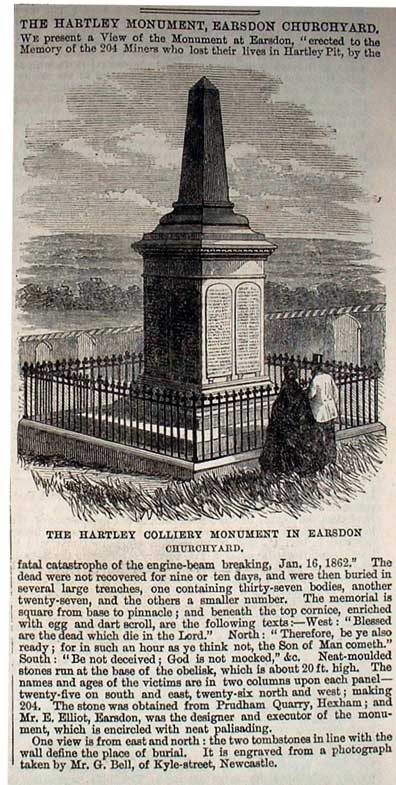 At Earsdon,
St Albans, a village in North Tyneside close to Whitley Bay, there is a Hartley
Memorial Monument to the Hartley Mine Disaster.
At Earsdon,
St Albans, a village in North Tyneside close to Whitley Bay, there is a Hartley
Memorial Monument to the Hartley Mine Disaster.
THE
HARTLEY CALAMITY
[Joseph Skipsey (1832-1903)]
THE Hartley men are noble, and Ye'll hear a tale of woe;
I'll tell the (loom of the Hartley men— The year of sixty-two.
'Twas on a Thursday morning, on The first month of the year,
When there befell the thing that well May rend the heart to hear.
Ere chanticleer with music rare Awakes the old homestead,
The Hartley men are up and off To earn their daily bread.
On, on they toil; with heat they broil, And streams of sweat still glue
The stour unto their skins, till they Are black as that they hew.
Now to and fro, the putters go The waggons to and fro,
And echoes clang of wheel and hoof Within the mine below.
The din and strife of human life Awake in "wall" and "borde,"
When, lo! a shock is felt which makes Each human heart-beat heard.
Each bosom thuds, as each his duds He snatches and away,
And to the shaft in terror flees With all the speed he may.
Each, all, they flee—by two—by three They seek the shaft, to seek
An answer in each other's face, To what they may not speak.
"Are we entombed?" they seem to ask, "The shaft is closed, and no
Escape have we to God's bright day From out the night below.
" So stand in pain the Hartley men, And o'er them swiftly comes
The memory of home and all That links us to our homes.
Despair at length renews their strength, And they the shaft must clear;
And soon the sound of mall and pick Half drowns the voice of fear.
And hark! to the blow of the mall below Do sounds above reply?
Hurra, hurra, for the Hartley men, For now their rescue's nigh.
Their rescue nigh? The sounds of joy And hope have ceased, and ere
A breath is drawn a rumble's heard Re-drives them to despair.
Together, now behold them bow; Their burden'd souls unload
In cries that never rise in vain Unto the living God.
Whilst yet they kneel, again they feel Their strength renew'd—again
The swing and the ring of the mall attests The might of the Hartley men.
And hark! to the blow of the mall below Do sounds above reply?
Hurra, hurra, for the Hartley men For now their rescue's nigh.
But lo! yon light, erewhile so bright No longer lights the scene;
A cloud of mist yon light hath kiss'd, And shorn it of its sheen.
A cloud of mist yon light hath kiss'd, See! how along it steals,
Till one by one the lights are smote, And deep the gloom prevails.
"O, father, till the shaft is rid Close, close beside me keep;
My eye-lids are together glued, And I—and I—must sleep."
"Sleep, darling, sleep, and I will keep Close by—heigh-ho!"— To keep
Himself awake the father strives; But he—he too—must sleep.
"O, brother, till the shaft is rid Close, close beside me keep;
My eye-lids are together glued, And I—and I—must sleep."
"Sleep, brother, sleep, and I will keep Close by—heigh-ho!"— To keep
Himself awake the brother strives; But he—he too—must sleep.
"O, mother dear! wert, wert then near Whilst—sleep!"—The orphan slept;
And all night long by the black pit-heap The mother a dumb watch kept.
And fathers and mothers, and sisters and brothers; The lover and the new-made
bride;
A vigil kept for those who slept, From eve to morning tide.
But they slept—still sleep—in silence dread, Two hundred old and young,
To awake when heaven and earth have sped, And the last dread trumpet rung!
A
pause for thoughts ...
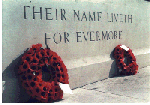

as a special tribute to all the HARTLEY Family members who have died in conflicts,
throughout time, all over the world.
visit the British Commonwealth War
Graves Commission Register
*New National Memorial Arboretum, Staffordshire, England
please bookmark this website address: hartleyfamily.uk
e-mail enquiries to: william@hartleyfamily.uk